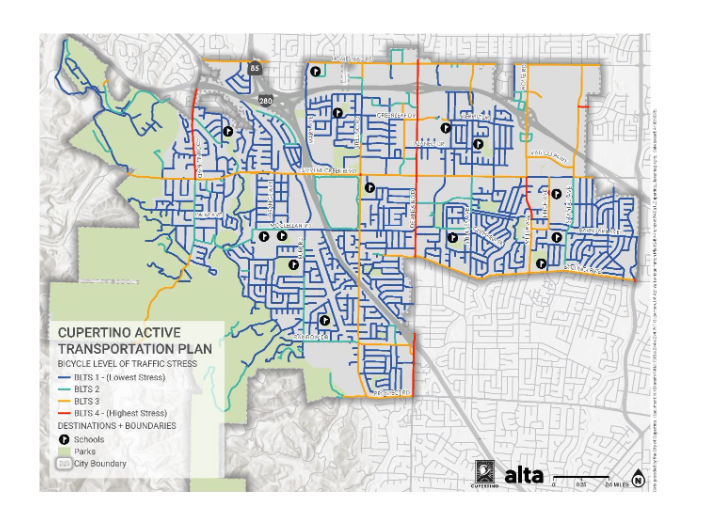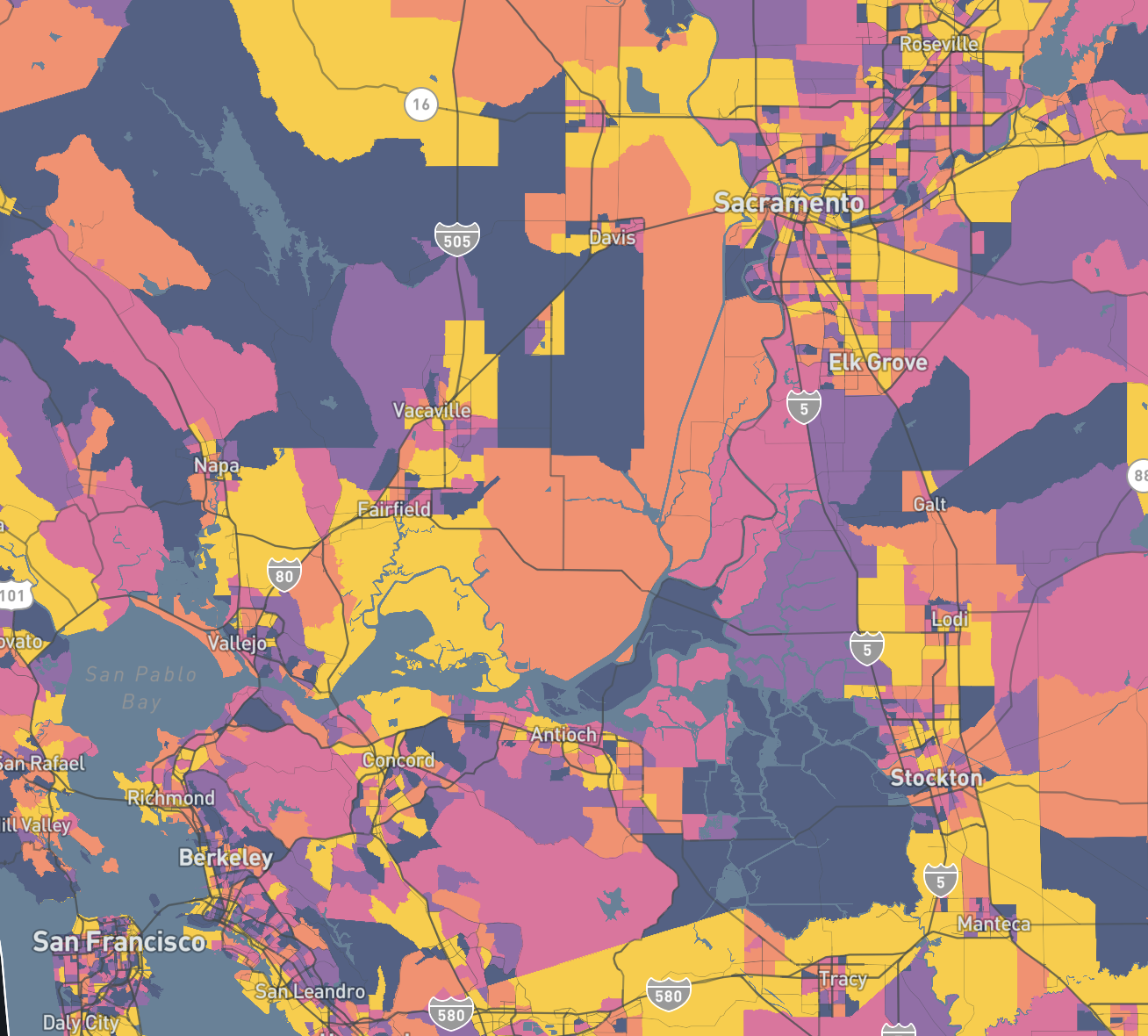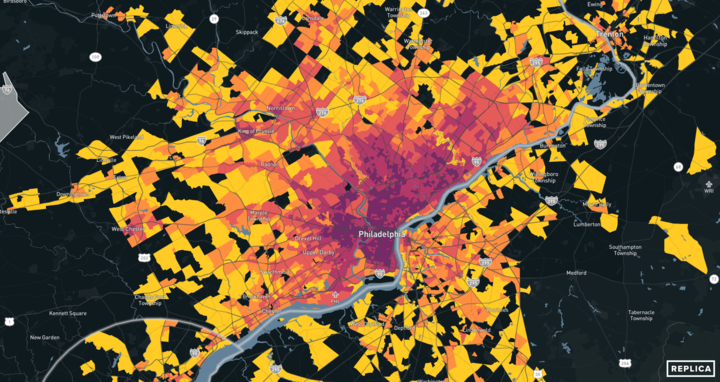We’re excited to announce that we’ve raised $41 million in a Series B round led by Founders Fund and with participation from all current investors, including Innovation Endeavors, Sidewalk Labs, Rise of the Rest Fund, and Firebrand.
When Replica started as a project inside of Sidewalk Labs more than four years ago, we had our sights set on understanding how people move within cities. Today, Replica has evolved into an independent company with a much bigger mission: to make complex, rapidly changing urban ecosystems easier to understand.
We’re inspired by how our customers are already using Replica to make better planning and operational decisions, whether it’s a state transportation official implementing a congestion pricing policy, a county budget official forecasting sales tax revenue, or a city planner studying the impact changing pandemic behavior will have on future mobility patterns.
From the beginning, we’ve known that achieving our mission depends on delivering against a small number of critically important requirements that require us to maintain a customer-first mentality, and they’re the same requirements we judge ourselves by today.
- Produce measurable, high-quality data outputs that don’t compromise privacy
- Put transportation in the larger urban context — because cities are too complex to be reduced simply to “mobility data”
- Deliver a product that is useful and accessible for anyone that works in the built environment
1. Measurable, high-quality data outputs that don’t compromise privacy
Prior to Replica, anyone seeking better insight about the built environment was forced into what we believe is a false trade-off: One could either find data that protected privacy OR one could find data that actually provided meaningful insight.
In practice, one could choose aggregate data that was over-generalized and lacked depth of insight (like zone-to-zone movements or relative changes without absolute counts) OR choose detailed data (like street-level movements or raw mobile-location data) that carries significant privacy and security risk, and where the volume of data makes insights hard to extract.
Replica’s technical approach solves for this false trade-off by using large-scale, computational-intensive simulations — often referred to as behavior models — to generate the data and insights we deliver to our customers.
Rather than simply cleansing, normalizing, and scaling individual data sources, we (1) create a synthetic population that matches the characteristics of a given region; (2) train a number of behavior models specific to that region; and (3) run simulations of those behavior models applied to the synthetic population in order to create a “replica” of transportation and economic patterns. This methodology is how Replica delivers granular data outputs that match behavior in aggregate but don’t surface the actual movements (or compromise the privacy) of any one individual.
This provides a number of meaningful benefits:
- It allows us to use a large composite of diverse input data, which prevents our outputs from over-assuming the inherent bias of any one data set. This is a significant challenge for vendors who rely solely on location-based services data.
- It allows us to provide disaggregate outputs — for each trip in our simulations, our customer can see granular details about the theoretical “trip-taker” and the “trip” itself. Replica is the only data provider that delivers this granular level of insight without compromising privacy.
- It allows us to represent behavior continuously in time and space — just like the real world. Being able to understand the nuances of time is critical — just ask anyone who’s witnessed the stark differences between weekday rush hour traffic versus an early outing on a Saturday morning.
Just as important, our methodology enables us to offer our customers an industry first and something we’ve been working on for over four years: automated calibration. Similar to other scientific testing, we always hold out some of our own data and compare our simulated outputs with aggregate control group data for quality and reporting purposes.
We also enable any customer to provide their own data for comparison and calibration. Cities, states, and transit agencies around the country have all contributed thousands of data sets — traffic counts, transit counts, pedestrian counts, sales tax receipts — all providing necessary checks and balances to the simulated outputs.
The benefit of this feature is immense. Not only does it increase trust and utilization for each individual client, but it also creates a community of customers helping one another. Every new agency that contributes data improves the quality for all other agencies. Over time, it also improves our simulation algorithms, increasing the velocity and quality of our outputs.
2. Recognizing that cities are more complex than just mobility
Too often, the work that’s done in cities focuses on one narrow question at a time. Sometimes that’s because of the way government is structured, or a lack of data, or because looking at secondary or tertiary effects is just too complex. Data providers often reinforce this view, offering a narrow focus like “big data for mobility.”
Of course, cities don’t operate in silos. Each new apartment building impacts traffic, which impacts commute times and methods, which impacts which coffee shop or restaurant thrives or fails, which impacts employment options, which impacts tax revenue, which impacts the ability to fund new infrastructure, which impacts the ability to attract new residents and employers, and so on.
At Replica, we embrace this complexity. For example, we’ve added a Consumer Spend metric so our customers can track economic health alongside mobility. And we plan to add more metrics, like land use, real estate, energy, and utility infrastructure data in order to give our customers a more holistic view of the city.
3. A product that is useful and accessible for anyone that works in the built environment
Building simulations that are privacy-friendly, high fidelity, and trusted already raises the bar for our industry — but we also want to ensure that the information can be accessed by a variety of users. We’ve spent a considerable amount of time learning alongside our customers to ensure that Replica is highly useful for data practitioners and policymakers alike. What inspires our various users? How do they need to receive and present their insights? How do insights translate into real-world implementations? By examining questions like these, we’ve designed a product and data interface, along with systems integrations, that help customers work more effectively. Our aim is to empower those working in the built environment to do their very best work.
What’s Next for Cities?
We are early in a long, mission-driven journey, and we’ve got a lot left to do. Here’s what’s highest-priority for our customers, and at the top of our list.
Post-Covid Planning, Operations, and Infrastructure:
The United States is in a generational transition period, creating a small window of opportunity for public agencies to shift and invest in infrastructure that represents the future of mobility rather than the past. Transit agencies are rethinking their services, cities are aggressively investing in bike and pedestrian infrastructure, and the proposed federal infrastructure bill contemplates a future with electric vehicles and cross-country rail service.
Getting these investments right depends on abandoning the historic method of planning — arbitrary, siloed decisions based on outdated data — and transitioning to a new model that is adaptable, responsive, and relies on near-real-time data. Our work with the MTA in New York, NJ Transit in New Jersey, and CTA in Chicago highlights what’s possible when high-quality, current data is used in the planning process. If you are working on this, click here.
Climate, Resiliency, and Equity:
Connecting transportation to land use, energy use, economic activity, and social services is critically important for more sustainable, resilient, and equitable cities. This type of cross-functional policymaking requires having trusted baseline information about what’s really happening today across each domain, and too often the data being used in policy-making is actually three to five years old.
As cities and states introduce policies to curb climate impacts, increase social equity, and jump-start economic growth, having trusted data that looks across time — past, present, and future — is fundamental. Replica is already helping the State of California analyze climate impacts, particularly vehicle miles traveled, and we have more plans to add data and product functionality that supports growing needs in these areas. If you are working on this, click here.
Future State Simulations:
The complexity of forecasting the future — often referred to as scenario modeling — means that too often, analysts are forced to rely on tools and methods far less nuanced than the problem being tackled. In many cases, Microsoft Excel serves as the primary tool for population and land use forecasts. And specialty transportation scenario modeling tools are often too crude, too slow, or too narrow to be truly useful. In either case, the entire process of forecasting is often so technical that it prevents wider participation even among planners, let alone the general public.
Replica is already preparing the launch of a better scenario-planning solution, which will empower all of our end users to simulate the future impact of today’s decisions. Replica’s Scenario solution will incorporate modern tooling and computing power efficiently and effectively, and will be delivered to customers in a way that’s both intuitive and accessible. We expect to release a beta product for Scenarios to a small number of customers soon. If you are working on this, click here.
Join Our Team
Finally, and importantly, we’re always looking for skilled, mission-driven, empathetic, customer-minded leaders to join our team. If you do your best work in a culture that’s diverse, ambitious, humble — and you are motivated to positively impact the world — reach out; we would love to speak with you.








